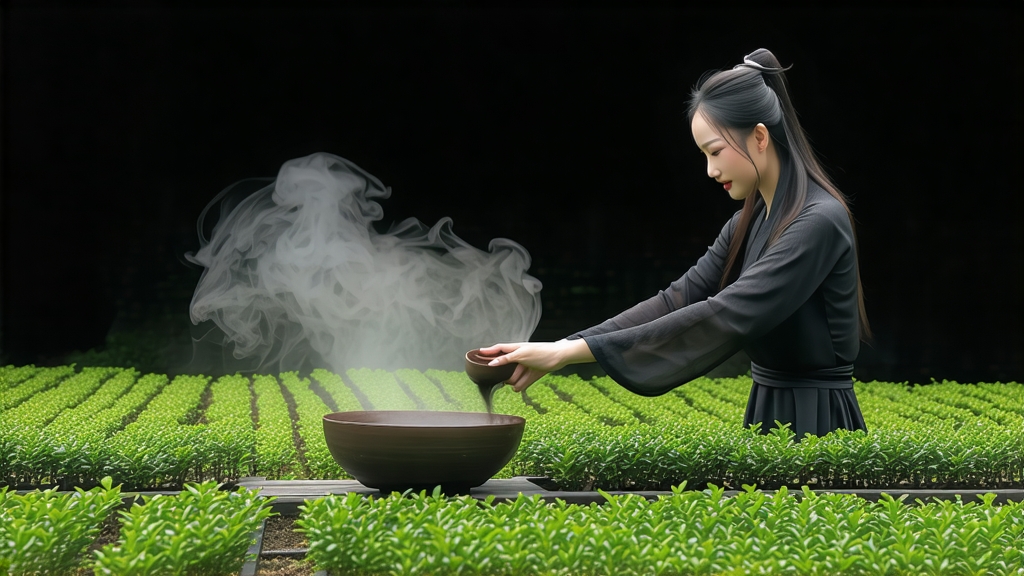
High in the mist-laden crevices of northern Fujian’s Wuyi Mountains, a six-tree grove of gnarled tea bushes clings to a nearly vertical rock face. For more than three centuries these bushes—known collectively as the “mother trees” of Da Hong Pao—have supplied the genetic and mythic blueprint for China’s most celebrated oolong. International headlines often reduce the story to million-dollar auctions, yet the true drama lies in the interplay of geology, craft, and palate that turns a leaf into liquid mineral perfume.
Historical whispers place the birth of Da Hong Pao in the late Ming dynasty. One popular tale tells of a Ming scholar who, cured of illness by tea plucked from these very cliffs, draped his crimson imperial robe over the bushes in gratitude. Whether legend or marketing, the name “Big Red Robe” stuck, and Qing-era court records already list “Yancha from Wuyi” as tribute tea reserved for the emperor. Caravans carried the dark, twisted leaves along the Nine-Dragon Gorge to the port of Xiamen, where Dutch and later British traders christened it “Bohea,” a corruption of “Wuyi,” propelling the tea into global circulation long before the word “oolong” entered English dictionaries.
Today the Wuyi Scenic Reserve harbors roughly forty indigenous cultivars eligible to wear the Da Hong Pao label, but three dominate commercial production: Bei Dou #1, cut directly from the 350-year-old mother trees; Que She (“Sparrow Tongue”), prized for tiny, orchid-fragrant leaves; and the more recently bred Qi Dan, whose deeper oxidation yields dark cocoa notes. All belong to the broader Yancha (rock tea) family, so named because the plants root directly into weathered tuff and granite, absorbing minerals that later translate into the coveted “yan yun” or “rock rhyme”—a tactile finish reminiscent of wet slate after a summer storm.
Craft begins on the cliff ledges at dawn, when experienced pickers climb bamboo scaffolding to harvest only the middle three leaves and the tender bud, a standard called “zhong kai mian.” The pluck must reach the factory—usually a small, family-run workshop tucked into a mountain hollow—within two hours. There, leaves are spread no thicker than three centimeters on water-permeable bamboo trays to wilt under the rising mountain sun. Solar withering lasts about thirty minutes, just long enough for the edges to turn satin-soft; handlers then shuffle the trays into a shaded corridor where cooler air encourages “water migration” from stem to leaf, priming the cellular structure for the bruising ahead.
Bruising, or yao qing, is where oolong diverges from green and black teas. Workers toss the wilted leaves into a cylindrical bamboo drum that rotates at fifteen revolutions per minute; the gentle tumbling cracks cell walls without breaking the surface, initiating oxidation only along the rim. Every ten minutes the drum stops, leaves are hand-tossed in the air like salad, and the aroma is checked for the tell-tale shift from grassy to peach-skin. After four cycles the leaf edges oxidize to a coppery red while the center stays moss-green, achieving the signature “green heart with red skirt” that defines semi-fermented tea.
Oxidation halts in a 220 °C electric roaster for seven minutes, hot enough to denature enzymes yet brief enough to preserve floral precursors. What follows is the most Yancha-specific step: two rounds of charcoal roasting separated by thirty days of rest. Using only the embers of local hardwoods—primarily longan and lychee—the tea master buries the leaf in horse-hair lined bamboo baskets, each basket covered by a thin cotton cloth to modulate heat. Temperature never exceeds 85 °C, demanding nightly attention for six straight hours; any hotter and the coveted minerality collapses into burnt toast. Between roastings the tea is allowed to “return to soul,” absorbing ambient humidity that reawakens aromatic molecules, a process analogous to the breathing of fine wine in barrel.
The finished leaf is midnight black with hints of mahogany, twisted into slender knotted strips that rattle like dry twigs when poured. Aroma dry is surprisingly subdued: hints of burnt caramel and dried apricot, but the true bouquet waits for hot water.
For brewing, Wuyi artisans recommend the Gongfu approach, not for ceremony but for control. A 120 ml pear-shaped gaiwan of thin porcelain conducts heat quickly, preventing the stewed notes that emerge